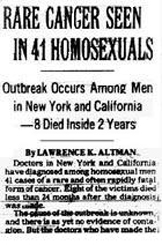About HIV/AIDS
Basic Facts About HIV
What is HIV?
HIV stands for human immunodeficiency virus. It is the virus that causes AIDS. When a person is infected with HIV, the virus enters the body and then resides and multiplies primarily in the white blood cells—the immune cells that normally protect us from disease.
What is AIDS?
AIDS stands for acquired immunodeficiency syndrome.
As HIV grows in an infected person, it damages or kills specific immune cells, weakening the immune system and leaving the person vulnerable to infections and illnesses ranging from pneumonia to cancer.
Only when someone with HIV begins to experience one or more of these conditions or loses a significant amount of immune cells are they diagnosed with AIDS.

HIV/AIDS in the U.S.

HIV/AIDS in the World

Snapshots of an Epidemic: An HIV/AIDS Timeline
Our chronicle of the HIV/AIDS pandemic begins in the summer of 1981, when the first cases of a mysterious and deadly new pathogen come to light.
HIV Resources
A wide range of local, national and international organizations conduct research and provide services, information and advocacy for individuals and communities affected by HIV.
